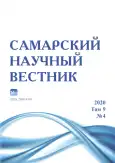Environmental factors influence on leeches distribution in the middle reaches of the Irtysh River
- Authors: Fedorova L.I.1
-
Affiliations:
- Surgut State University
- Issue: Vol 9, No 4 (2020)
- Pages: 159-164
- Section: General Biology
- URL: https://journals.rcsi.science/2309-4370/article/view/59470
- DOI: https://doi.org/10.17816/snv202094124
- ID: 59470
Cite item
Full Text
Abstract
The Irtysh River is a transboundary watercourse that exhibits a wide range of climatic conditions, environments and ecological niches. As a result of the technogenic impact of industrial enterprises on surface and underground waters – all the main tributaries of the middle reaches of the river Irtysh are in different degrees of pollution. Due to the impact of sewage and other wastes from the mining and metallurgical industry, in the waters of the river basin Irtysh the concentration excess of a number of toxic metals is observed. Among the invertebrates used to assess the state of natural waters, representatives of the Annelida type are often used. Since annelids are among the most common organisms on Earth, this makes it possible to study them in many regions and to assess the specificity of the impact and compare the impact of various pollutants in similar natural and climatic zones. It is known that the distribution of freshwater leeches is largely determined by natural and climatic conditions, landscape characteristics and the specifics of trophic connections, etc. In this case, the most important parameters are the physicochemical properties of water. This paper provides information on the factors influencing the species composition and structural indicators of leech communities living in the middle reaches of the Irtysh River.
Full Text
##article.viewOnOriginalSite##About the authors
Lyudmila Ivanovna Fedorova
Surgut State University
Author for correspondence.
Email: ludiko@list.ru
candidate of biological sciences, senior researcher of Scientific and Educational Center of Natural and Technical Sciences Institute
Russian Federation, SurgutReferences
- Бейсембаева М.А., Дубровская Л.И., Земцов В.А. Антропогенные изменения водных ресурсов и максимальных уровней реки Иртыш в равнинной части бассейна в Республике Казахстан // Известия Томского университета. Инжиниринг георесурсов. 2018. Т. 329, № 3. С. 6–15.
- Abubakr A., Gojar A.A., Balkhi M.H., Malik R. Macro-invertebrates (Annelida; Oligochaeta) as bio-Indicator of water quality under temperate climatic conditions // International Journal of Pure & Applied Bioscience. 2018. Vol. 6, iss. 1. P. 726–737.
- Захаров А.Б., Лоскутова О.А., Фефилова Е.Б., Хохлова Л.Г., Шубин Ю.П. Сообщества гидробионтов нефтезагрязненных акваторий бассейна реки Печора. Сыктывкар: Коми НЦ УрО РАН, 2011. 268 с.
- Баянов Н.Г. ООПТ и совершенствование мониторинга водных экосистем в России // Астраханский вестник экологического образования. 2013. № 4 (26). С. 82–88.
- Демшин Н.И. Олигохеты и пиявки как промежуточные хозяева гельминтов. Новосибирск: Изд-во: «Наука», 1975. 190 с.
- Faisal M. High prevalence of buccal ulcerations in largemouth bass, Micropterus salmoides (Centrarchidae) from Michigan inland lakes associated with Myzobdella lugubrisLeidy 1851 (Annelida: Hirudinea) // Parasite. 2011. Vol. 18, № 1. P. 79–84.
- Trivalairat P., Chiangkul K., Purivirojkul W. Placobdelloides sirikanchanae sp. nov., a new species of glossiphoniid leech and a parasite of turtles from lower southern Thailand (Hirudinea, Rhynchobdellida) // ZooKeys. 2019. Vol. 882. P. 1–24.
- Koperski P. Taxonomic, phylogenetic and functional diversity of leeches (Hirudinea) and their suitability in biological assessment of environmental quality // Knowledge and Management of Aquatic Ecosystems. 2017. Vol. 418. P. 49.
- Cortelezzi A., Gullo B.S., Simoy M.V., Cepeda R.E., Marinelli C.B., Capitulo A.R., Berkunsky Assessing the sensitivity of leeches as indicators of water quality // Science of the Total Environment. 2018. Vol. 624. P. 1244–1249.
- Куликов Е.В. Возможные последствия для рыбного хозяйства на Иртыше увеличения забора воды в КНР // Известия Челябинского научного центра УрО РАН. 2007. Вып. 4 (38). С. 55–58.
- Сарсембенова О.Ж. Уровень загрязнения поверхностных вод в районах влияния городов и промышленных центров // Научный альманах. 2015. № 9 (11). С. 809–812.
- Плащев А.В., Чекмараев В.А. Гидрография СССР. Л.: Гидрометиздат. 1967. 287 с.
- Бурлибаев М.Ж. и др. Динамика режима гидрохимических токсикологических параметров в трансграничной реке Иртыш и характер их трансформации // Водное хозяйство Казахстана. 2012. № 12 (50). С. 9–20.
- Бурлибаев М.Ж. и др. Проблемы загрязнения основных трансграничных рек Казахстана. Алматы: Изд-во «Каганат», 2014. Т. 1. 744 с.
- Лукин Е.И. Пиявки пресных и солоноватых водоемов (фауна пиявок СССР). Л.: Наука, 1976. 284 с.
- Nesemann H. Clitellata, Branchiobdellada, Acanthobdellada, Hirudinea // Susswasserfauna von Mitteleuropa. Heidelberg / eds.: J. Schwoebel, P. Zwig. Berlin: Spectrum Akademischer Verlag, 1999. Vol. 6 (2). 178 p.
- Oksanen J., Kindt R., Legendre P. et al. The vegan package // Community Ecology Package. 2007. Vol. 10. P. 631–637.
- Oksanen J. Multivariate analysis of ecological communities in R: vegan tutorial // R Package Version. 2011. Vol. 1 (7). P. 11–12.
- Hollander M., Wolfe D.A. Nonparametric statistical methods. New York: John Wiley & Sons, 1973. 528 p.
- Warnes et al. Gplots: Various R Programming tools for plotting data. R package version 2.17.0 [Internet] // http://CRAN.R-project.org/package=gplots.
Supplementary files








